Zhenghao Chen
School of Electrical and Information Engineering, The University of Sydney, Australia
4DGS-Craft: Consistent and Interactive 4D Gaussian Splatting Editing
Oct 02, 2025Abstract:Recent advances in 4D Gaussian Splatting (4DGS) editing still face challenges with view, temporal, and non-editing region consistency, as well as with handling complex text instructions. To address these issues, we propose 4DGS-Craft, a consistent and interactive 4DGS editing framework. We first introduce a 4D-aware InstructPix2Pix model to ensure both view and temporal consistency. This model incorporates 4D VGGT geometry features extracted from the initial scene, enabling it to capture underlying 4D geometric structures during editing. We further enhance this model with a multi-view grid module that enforces consistency by iteratively refining multi-view input images while jointly optimizing the underlying 4D scene. Furthermore, we preserve the consistency of non-edited regions through a novel Gaussian selection mechanism, which identifies and optimizes only the Gaussians within the edited regions. Beyond consistency, facilitating user interaction is also crucial for effective 4DGS editing. Therefore, we design an LLM-based module for user intent understanding. This module employs a user instruction template to define atomic editing operations and leverages an LLM for reasoning. As a result, our framework can interpret user intent and decompose complex instructions into a logical sequence of atomic operations, enabling it to handle intricate user commands and further enhance editing performance. Compared to related works, our approach enables more consistent and controllable 4D scene editing. Our code will be made available upon acceptance.
On-Device Diffusion Transformer Policy for Efficient Robot Manipulation
Aug 01, 2025Abstract:Diffusion Policies have significantly advanced robotic manipulation tasks via imitation learning, but their application on resource-constrained mobile platforms remains challenging due to computational inefficiency and extensive memory footprint. In this paper, we propose LightDP, a novel framework specifically designed to accelerate Diffusion Policies for real-time deployment on mobile devices. LightDP addresses the computational bottleneck through two core strategies: network compression of the denoising modules and reduction of the required sampling steps. We first conduct an extensive computational analysis on existing Diffusion Policy architectures, identifying the denoising network as the primary contributor to latency. To overcome performance degradation typically associated with conventional pruning methods, we introduce a unified pruning and retraining pipeline, optimizing the model's post-pruning recoverability explicitly. Furthermore, we combine pruning techniques with consistency distillation to effectively reduce sampling steps while maintaining action prediction accuracy. Experimental evaluations on the standard datasets, \ie, PushT, Robomimic, CALVIN, and LIBERO, demonstrate that LightDP achieves real-time action prediction on mobile devices with competitive performance, marking an important step toward practical deployment of diffusion-based policies in resource-limited environments. Extensive real-world experiments also show the proposed LightDP can achieve performance comparable to state-of-the-art Diffusion Policies.
3D Gaussian Splatting Data Compression with Mixture of Priors
May 06, 2025Abstract:3D Gaussian Splatting (3DGS) data compression is crucial for enabling efficient storage and transmission in 3D scene modeling. However, its development remains limited due to inadequate entropy models and suboptimal quantization strategies for both lossless and lossy compression scenarios, where existing methods have yet to 1) fully leverage hyperprior information to construct robust conditional entropy models, and 2) apply fine-grained, element-wise quantization strategies for improved compression granularity. In this work, we propose a novel Mixture of Priors (MoP) strategy to simultaneously address these two challenges. Specifically, inspired by the Mixture-of-Experts (MoE) paradigm, our MoP approach processes hyperprior information through multiple lightweight MLPs to generate diverse prior features, which are subsequently integrated into the MoP feature via a gating mechanism. To enhance lossless compression, the resulting MoP feature is utilized as a hyperprior to improve conditional entropy modeling. Meanwhile, for lossy compression, we employ the MoP feature as guidance information in an element-wise quantization procedure, leveraging a prior-guided Coarse-to-Fine Quantization (C2FQ) strategy with a predefined quantization step value. Specifically, we expand the quantization step value into a matrix and adaptively refine it from coarse to fine granularity, guided by the MoP feature, thereby obtaining a quantization step matrix that facilitates element-wise quantization. Extensive experiments demonstrate that our proposed 3DGS data compression framework achieves state-of-the-art performance across multiple benchmarks, including Mip-NeRF360, BungeeNeRF, DeepBlending, and Tank&Temples.
Neural Stereo Video Compression with Hybrid Disparity Compensation
Apr 29, 2025

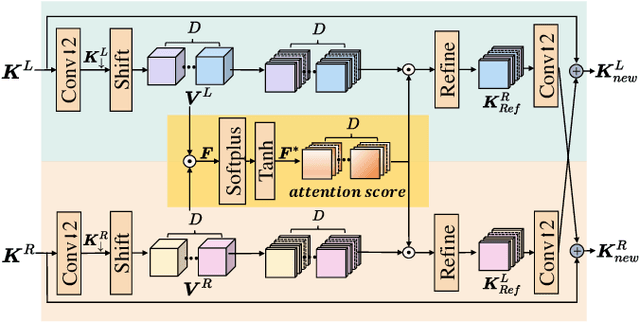
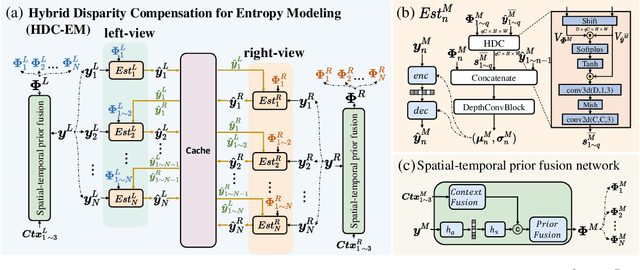
Abstract:Disparity compensation represents the primary strategy in stereo video compression (SVC) for exploiting cross-view redundancy. These mechanisms can be broadly categorized into two types: one that employs explicit horizontal shifting, and another that utilizes an implicit cross-attention mechanism to reduce cross-view disparity redundancy. In this work, we propose a hybrid disparity compensation (HDC) strategy that leverages explicit pixel displacement as a robust prior feature to simplify optimization and perform implicit cross-attention mechanisms for subsequent warping operations, thereby capturing a broader range of disparity information. Specifically, HDC first computes a similarity map by fusing the horizontally shifted cross-view features to capture pixel displacement information. This similarity map is then normalized into an "explicit pixel-wise attention score" to perform the cross-attention mechanism, implicitly aligning features from one view to another. Building upon HDC, we introduce a novel end-to-end optimized neural stereo video compression framework, which integrates HDC-based modules into key coding operations, including cross-view feature extraction and reconstruction (HDC-FER) and cross-view entropy modeling (HDC-EM). Extensive experiments on SVC benchmarks, including KITTI 2012, KITTI 2015, and Nagoya, which cover both autonomous driving and general scenes, demonstrate that our framework outperforms both neural and traditional SVC methodologies.
Deep Learning for Time Series Forecasting: A Survey
Mar 13, 2025Abstract:Time series forecasting (TSF) has long been a crucial task in both industry and daily life. Most classical statistical models may have certain limitations when applied to practical scenarios in fields such as energy, healthcare, traffic, meteorology, and economics, especially when high accuracy is required. With the continuous development of deep learning, numerous new models have emerged in the field of time series forecasting in recent years. However, existing surveys have not provided a unified summary of the wide range of model architectures in this field, nor have they given detailed summaries of works in feature extraction and datasets. To address this gap, in this review, we comprehensively study the previous works and summarize the general paradigms of Deep Time Series Forecasting (DTSF) in terms of model architectures. Besides, we take an innovative approach by focusing on the composition of time series and systematically explain important feature extraction methods. Additionally, we provide an overall compilation of datasets from various domains in existing works. Finally, we systematically emphasize the significant challenges faced and future research directions in this field.
Improving Lesion Segmentation in Medical Images by Global and Regional Feature Compensation
Feb 12, 2025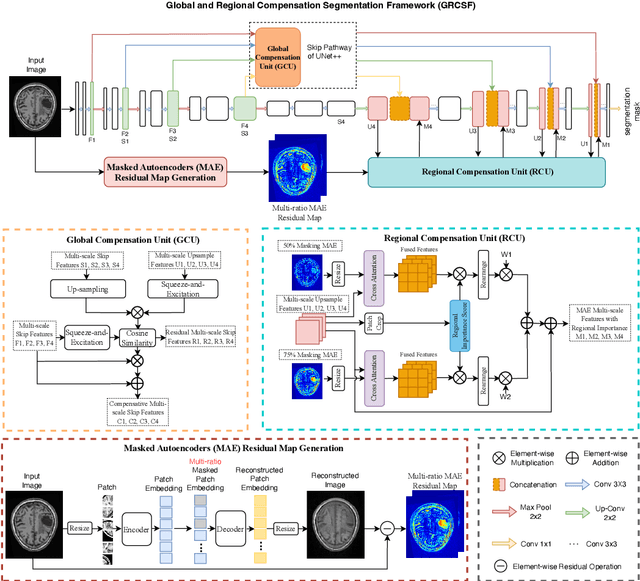
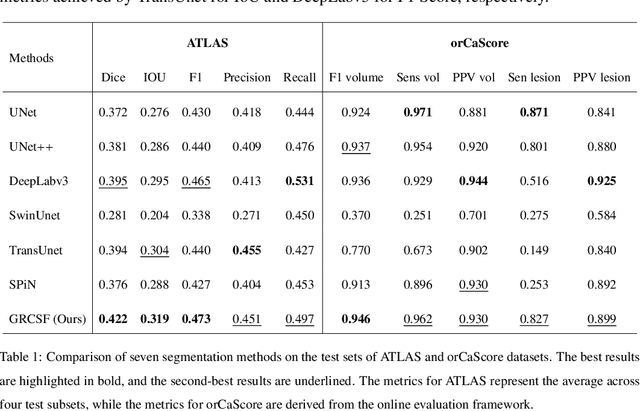
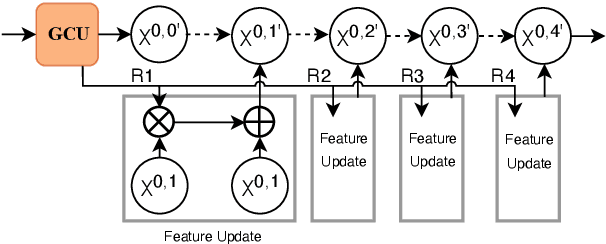
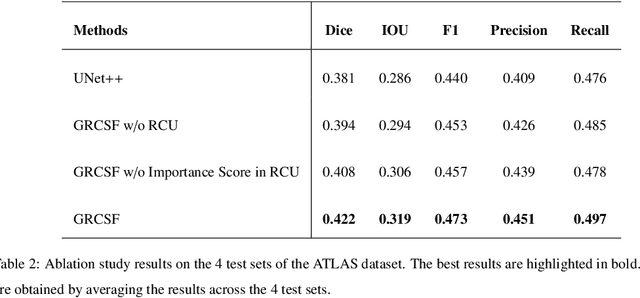
Abstract:Automated lesion segmentation of medical images has made tremendous improvements in recent years due to deep learning advancements. However, accurately capturing fine-grained global and regional feature representations remains a challenge. Many existing methods obtain suboptimal performance on complex lesion segmentation due to information loss during typical downsampling operations and the insufficient capture of either regional or global features. To address these issues, we propose the Global and Regional Compensation Segmentation Framework (GRCSF), which introduces two key innovations: the Global Compensation Unit (GCU) and the Region Compensation Unit (RCU). The proposed GCU addresses resolution loss in the U-shaped backbone by preserving global contextual features and fine-grained details during multiscale downsampling. Meanwhile, the RCU introduces a self-supervised learning (SSL) residual map generated by Masked Autoencoders (MAE), obtained as pixel-wise differences between reconstructed and original images, to highlight regions with potential lesions. These SSL residual maps guide precise lesion localization and segmentation through a patch-based cross-attention mechanism that integrates regional spatial and pixel-level features. Additionally, the RCU incorporates patch-level importance scoring to enhance feature fusion by leveraging global spatial information from the backbone. Experiments on two publicly available medical image segmentation datasets, including brain stroke lesion and coronary artery calcification datasets, demonstrate that our GRCSF outperforms state-of-the-art methods, confirming its effectiveness across diverse lesion types and its potential as a generalizable lesion segmentation solution.
Valley2: Exploring Multimodal Models with Scalable Vision-Language Design
Jan 13, 2025



Abstract:Recently, vision-language models have made remarkable progress, demonstrating outstanding capabilities in various tasks such as image captioning and video understanding. We introduce Valley2, a novel multimodal large language model designed to enhance performance across all domains and extend the boundaries of practical applications in e-commerce and short video scenarios. Notably, Valley2 achieves state-of-the-art (SOTA) performance on e-commerce benchmarks, surpassing open-source models of similar size by a large margin (79.66 vs. 72.76). Additionally, Valley2 ranks second on the OpenCompass leaderboard among models with fewer than 10B parameters, with an impressive average score of 67.4. The code and model weights are open-sourced at https://github.com/bytedance/Valley.
An Efficient Adaptive Compression Method for Human Perception and Machine Vision Tasks
Jan 08, 2025



Abstract:While most existing neural image compression (NIC) and neural video compression (NVC) methodologies have achieved remarkable success, their optimization is primarily focused on human visual perception. However, with the rapid development of artificial intelligence, many images and videos will be used for various machine vision tasks. Consequently, such existing compression methodologies cannot achieve competitive performance in machine vision. In this work, we introduce an efficient adaptive compression (EAC) method tailored for both human perception and multiple machine vision tasks. Our method involves two key modules: 1), an adaptive compression mechanism, that adaptively selects several subsets from latent features to balance the optimizations for multiple machine vision tasks (e.g., segmentation, and detection) and human vision. 2), a task-specific adapter, that uses the parameter-efficient delta-tuning strategy to stimulate the comprehensive downstream analytical networks for specific machine vision tasks. By using the above two modules, we can optimize the bit-rate costs and improve machine vision performance. In general, our proposed EAC can seamlessly integrate with existing NIC (i.e., Ball\'e2018, and Cheng2020) and NVC (i.e., DVC, and FVC) methods. Extensive evaluation on various benchmark datasets (i.e., VOC2007, ILSVRC2012, VOC2012, COCO, UCF101, and DAVIS) shows that our method enhances performance for multiple machine vision tasks while maintaining the quality of human vision.
HEMGS: A Hybrid Entropy Model for 3D Gaussian Splatting Data Compression
Nov 27, 2024



Abstract:Fast progress in 3D Gaussian Splatting (3DGS) has made 3D Gaussians popular for 3D modeling and image rendering, but this creates big challenges in data storage and transmission. To obtain a highly compact 3DGS representation, we propose a hybrid entropy model for Gaussian Splatting (HEMGS) data compression, which comprises two primary components, a hyperprior network and an autoregressive network. To effectively reduce structural redundancy across attributes, we apply a progressive coding algorithm to generate hyperprior features, in which we use previously compressed attributes and location as prior information. In particular, to better extract the location features from these compressed attributes, we adopt a domain-aware and instance-aware architecture to respectively capture domain-aware structural relations without additional storage costs and reveal scene-specific features through MLPs. Additionally, to reduce redundancy within each attribute, we leverage relationships between neighboring compressed elements within the attributes through an autoregressive network. Given its unique structure, we propose an adaptive context coding algorithm with flexible receptive fields to effectively capture adjacent compressed elements. Overall, we integrate our HEMGS into an end-to-end optimized 3DGS compression framework and the extensive experimental results on four benchmarks indicate that our method achieves about 40\% average reduction in size while maintaining the rendering quality over our baseline method and achieving state-of-the-art compression results.
Individual Content and Motion Dynamics Preserved Pruning for Video Diffusion Models
Nov 27, 2024



Abstract:The high computational cost and slow inference time are major obstacles to deploying the video diffusion model (VDM) in practical applications. To overcome this, we introduce a new Video Diffusion Model Compression approach using individual content and motion dynamics preserved pruning and consistency loss. First, we empirically observe that deeper VDM layers are crucial for maintaining the quality of \textbf{motion dynamics} e.g., coherence of the entire video, while shallower layers are more focused on \textbf{individual content} e.g., individual frames. Therefore, we prune redundant blocks from the shallower layers while preserving more of the deeper layers, resulting in a lightweight VDM variant called VDMini. Additionally, we propose an \textbf{Individual Content and Motion Dynamics (ICMD)} Consistency Loss to gain comparable generation performance as larger VDM, i.e., the teacher to VDMini i.e., the student. Particularly, we first use the Individual Content Distillation (ICD) Loss to ensure consistency in the features of each generated frame between the teacher and student models. Next, we introduce a Multi-frame Content Adversarial (MCA) Loss to enhance the motion dynamics across the generated video as a whole. This method significantly accelerates inference time while maintaining high-quality video generation. Extensive experiments demonstrate the effectiveness of our VDMini on two important video generation tasks, Text-to-Video (T2V) and Image-to-Video (I2V), where we respectively achieve an average 2.5 $\times$ and 1.4 $\times$ speed up for the I2V method SF-V and the T2V method T2V-Turbo-v2, while maintaining the quality of the generated videos on two benchmarks, i.e., UCF101 and VBench.
 Add to Chrome
Add to Chrome Add to Firefox
Add to Firefox Add to Edge
Add to Edge